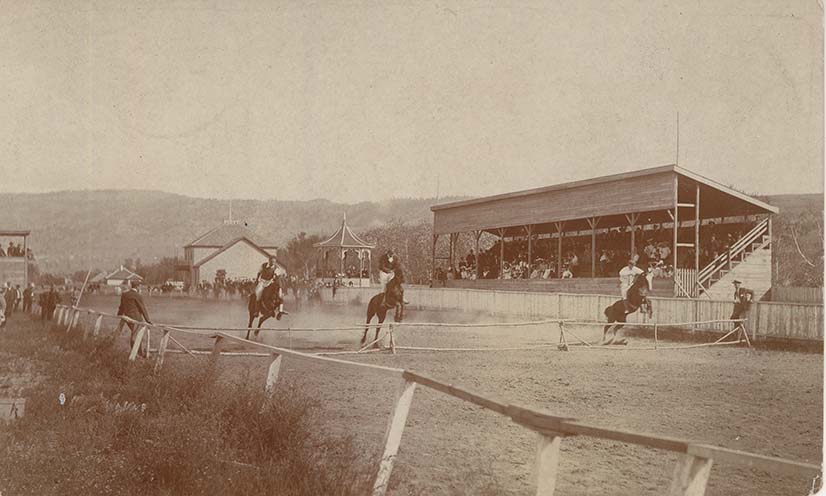Alexandra Park
May Day at Alexandra Park – This is a 1904 photograph by JJ Carment, is a view of the May Pole and crowd at Alexandra Park in North Kamloops.
The Origins of McDonald Park
What is now known as McDonald Park is a part of a larger Alexandra Park of the early 1900’s. The Park was the site of many activities as Kamloops developed more and larger events for the entertainment of its citizens. It is on the unceded land of the Tk’emlúps te Secwépemc.
Alexandra Park came into existence on July 6, 1901 when the Kamloops Agricultural Association (KAA) purchased 40 acres (16 Hectares) of land from the Hudson’s Bay Company (HBC). The annual exhibition was increasingly popular and was requiring more space.[1] The purchased land included 1800 feet (49 Meters) of Thompson River waterfront on the north shore and the land south of the current Mackenzie Ave between Park and Knox Streets.
Development began immediately. By July 30, the property had been surveyed and fencing delivered. The directors named the grounds, “Alexandra Park” in honour of the new Queen Alexandra[2], but many referred to the area as the “Exhibition Grounds.”
By September, fencing, a main building (Exhibition Hall), a grandstand and stables were completed. A ½ mile race track was ready and the grounds were prepared for a football match between Kamloops and Revelstoke. The contractor, Mr. Bain, expedited work on the first north shore bridge in preparation for the Sept 25, 1901 opening of the KAA Exhibition.

First West End bridge showing the site of North Kamloops. This bridge was built during the winter of 1900-1901 and temporarily opened in September in time for the first agricultural exhibition in North Kamloops. Image is from the south shore, showing site of the first Golf Course looking toward the Exhibition Grounds on the north shore.
Alexandra Park for Major Events
The Agricultural Exhibition
On September 25, a temporary opening of the unfinished west end bridge allowed a parade of dignitaries from the City into Alexandra Park and access for those attending the first fair on the north shore grounds (see also White Bridge on The North shore Bridges web story). A large crowd attended who arrived by paddle-wheeler, ferry, steamboat or private launch. The horse races were especially popular, as were the entries of livestock, poultry, preserves, crafts, art work, as well as entries of machinery and household equipment.

Trotting race at Alexandra Park on north shore soon after the park was established in September 1901.
In 1902, lack of water was the main issue for the developing park. The City Council was successfully petitioned for assistance, resulting in the installation of a water line across the bridge to the park. The Government insisted the pipe be removed from the bridge but that was not done before a fire broke out on July 18 requiring a lengthy bridge closure for repairs. It is thought a spark from a steamboat ignited the wooden bridge, and the pipe was a hazard in dealing with the fire.
On August 14, 1903, a full description of the many major improvements and additions to the grounds was on the front page of the The Inland Sentinel, under the heading,” Directors Make Notable Improvements and Addition to Grounds and Buildings.” It stated, in part, “The directors of the Kamloops Agricultural Association are to be congratulated on the great improvements made this season to their grounds and visitors will be much pleased with the efforts being made to keep down the dust and beautify the park” (Inland Sentinel, August 14, 1903, p1).
The article ends with a tribute to the “public spirit” of the directors of the KAA, “who at considerable disadvantage to themselves financially, have shown such interest in making the park attractive and a pleasant resort for the citizens of Kamloops and vicinity who, it is safe to say, will not be slow to appreciate it and afford the Association the support which at all times it deserves “(Ibid).[3]
By 1904, the annual fair had been attracting an increasing variety of entries for prizes, including not only livestock, crafts, produce, poultry, and preserves, but also bottled beer, machinery and household items. The fair was advertised as “The Kamloops Industrial Exhibition and Fall Race Meet” (The Kamloops Standard, September 17, 1904,p 5)
Racetrack with Grandstand, about 1905.
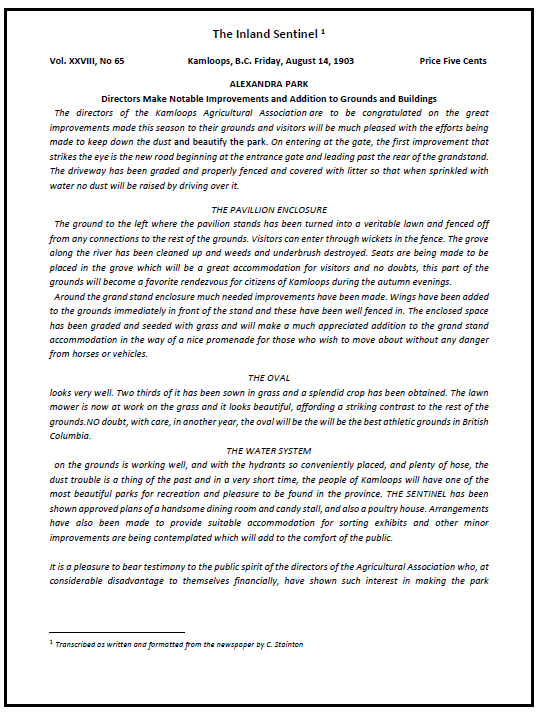
1st exhibition garden display from Carter and Dee, Fruitlands in the 1907 Exhibition at the N.K. Agricultural Hall. (Alexandra Park Hall).
B.C. Horse in training at the North Kamloops Exhibitions Grounds, 1909.
Second Canadian Mountain Rangers camp. 1911, in Alexandra Park, North Kamloops.
Over the years, the annual KAA exhibition and various other activities took place, some of which also became annual events. Some events were more specific to a sport or group such as Rocky Mountain Rangers.
It is not known to what extent the members of the Shuswap Nation participated in these Exhibitions but it is known they were excellent horse riders. A search will be done when the Secwépemc Museum and Heritage Park reopens.
By 1910, Polo Grounds were added north-west of the Exhibition Grounds, with Leigh Road, the northern border.
View of the north shore Polo Grounds
Children’s May Festivals[4]
As the city developed its transportation network, economic base and residential neighbourhoods, “Kamloops was concerned with enhancing its image as a dynamic and progressive place to live” (Norton, W. & Schmidt, W, (Eds). Reflections: Thompson Valley Histories, Plateau Press, Vancouver, 1994, p 101). One aspect was the national belief that the education and nurture of children was important and led to annual May festivals, “one of the most enduring traditions in this city’s history” (Ibid).
On May 1st, 1903, Alexandra Park was filled with enthusiastic children, parents and dignitaries for the first “Firemen’s May Day.” The Kamloops Fire Department, based on the initiative of the fire department in New Westminster, had organized a great event for children. A parade began at the Kamloops Musical and Athletic Association Hall[5] in the 100 block of Victoria St. and crossed the White Bridge and entered Alexandra Park.

May Day with crowd and Wheel Horse and Buggy (1905)
The Rocky Mountain Rangers Band led the parade with decorated carriages carrying dignitaries and the May Queen and her Maids of Honour, followed by children with decorated wagons, doll carriages, cycles of all sizes, motorcars and carriages, and pedestrians carrying banners. After being crowned, 13 year old Queen, Edith Lee, commanded the activities to begin. A Maypole dance was performed by the children and “the parade reformed to accompany the royal party to the Queen’s home where her mother provided dinner for her royal and civic guests” (Norton, p.34-35). A dance followed at the Association Hall, “with adults permitted on the floor before 10 o’clock only if their dance partners were children” (p35).
In 1905, a front page story detailed descriptions of all the May Day events with a long list winners in the many children’s events that were held. The parade that year was reassembled after the speeches to proceed past the new Fire Hall on Mackenzie Ave.
The firemen continued to be the organizers for several years until the event was moved in 1907 to near the Red Bridge as Alexandra Park was considered too “dry and dusty for comfort ” (Inland Sentinel, April 30, 1907, p.1).[6] The event stopped in 1913 but was revived and expanded in 1920 after the war with the HBC paying all expenses. From 1921, The May Day dancers sometimes performed for residents of Tranquille Sanitarium or the Royal Inland Hospital. The last event was in 1949 as interests changed.
Flying Machine Introduced 1911
At the 1911 Dominion Day (July 1) celebrations in Alexandra Park, William Wallace Gibson, a British designer of kites and airborne machines, planned to demonstrate that his machine would lift off the ground in front of the grandstand, showing a possible future of flying for both faster travel and commerce. The plane was dismantled for transport from the lower mainland via railway, then taken across the White Bridge and reassembled in the Park.
Poor weather prevented Gibson’s plane from lifting into the air as promised (The Inland Sentinel, Kamloops, B.C., June 30, 1911). Several excited men and boys climbed over a back fence to avoid paying the entrance fee to see this machine. The refund offered at the front gate was happily collected by 30 of them creating a loss for the Fair that year!
KAA Financial Problems:
The Kamloops Agricultural Association had constant difficulty supporting the development and maintenance of the beautiful and busy park they had created. Requests to the City for financial assistance were frequent and not always successful, as the City favoured a south shore location.
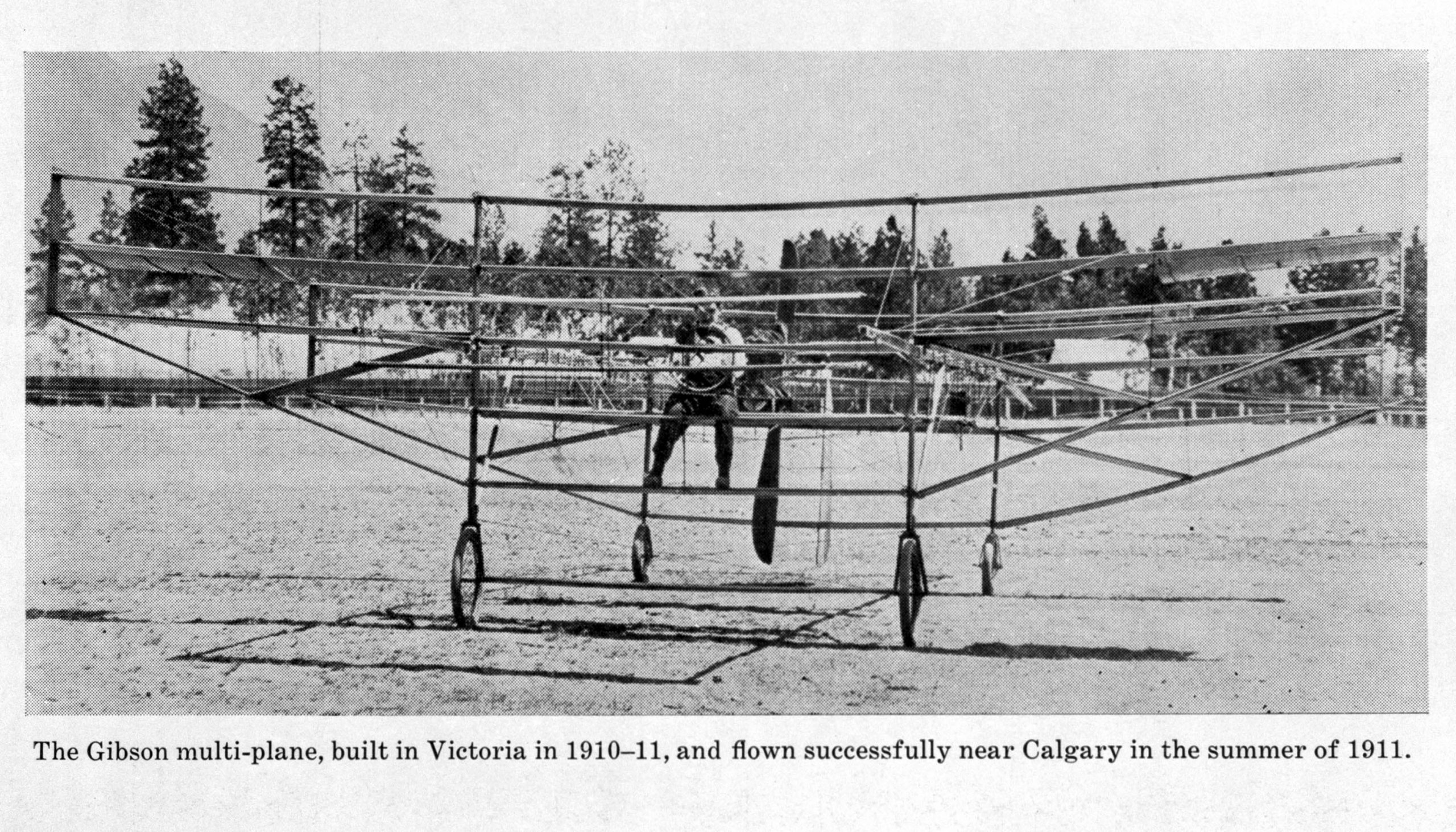
23160-20/b 22396. Gibsons Multiplane The Magnificent Distances, W.Q.W. Gibson – Multiplane Aircraft with permission of BC Provincial Archives.
Money was borrowed, debentures were sold, but financial difficulties continued. The desperate Association offered some lots for sale on the periphery of the park but developers were surveying for prime riverfront residential lots.
Alexandra Park Sold
In 1910, the Association offered the Park to the City but the citizens voted against the City borrowing the money for the purchase. Alexandra Park was sold in July, 1911 to Thomas Campbell for $35,000. He agreed to the Agricultural Association’s use of the park for their Exhibition that September.[7] Thomas Campbell hired McGillivray & Leighton who were able to sell lots and sub-divisions in Alexandra Park. A portion was bought for residential development by “a syndicate of local people for $50,000” in 1912 (Inland Sentinel, May 11, 1912, p.5). Parts of the park continued to be popular for polo, baseball and horse racing.
By 1912, the Agricultural Exhibition was not held as the Association was in debt. The Exhibition Grounds (Alexandra Park) continued to be used for horse racing and other events. In February, 1912, plots of Alexandra Park land were being offered for sale by realtors in Kamloops, while exhibition facilities were being developed in Riverside Park.
First Airplane Landing in Kamloops: August 1, 1919
An exciting and historical event in Alexandra Park was reported as: “The citizens of Kamloops have been treated to quite a bit of excitement since the arrival of E.O. Hall in the city late Friday evening in his airplane, the first one that has ever flown into the city” (The Kamloops’s Standard Sentinel Aug 5th, 1919, p. 1). Lieut. Hall, a Royal Air Force pilot, who, like other surviving pilots of WWI, continued to use his excellent piloting skills to support his love of flying. He flew into Kamloops on August 1, 1919, did loops and spins before landing first in the remaining grounds still known and used as Alexandra Park. He then flew to land on the Indian Reserve, having attracted a crowd of citizens who wanted to see the plane and take up the offer of a ride for $15.
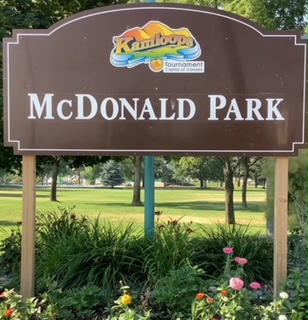
The Development of McDonald Park
The opening of the White Bridge in 1901 made the north shore more attractive for residential development and also to settlers who found land they could develop into productive farms. Canadian Real Properties, based in England, purchased most of the land on the north shore in 1903, incorporating as BC Fruitlands in 1909. The land around and in Alexandra Park, owned by B.C. Fruitlands, was being sold for residential use. It was surrounded by farms and orchards (see Fruitlands).
One developer who bought Alexandra Park land for a housing development had the foresight to designate a portion to remain as a park. “The neighbourhood surrounding Alexandra Park took ownership of part of the exhibition grounds as a neighbourhood park in the 1940’s” (McDonald Park Neighbourhood Plan, p.18).[8] It is not clear when the actual development of the park began or by whom. The racetrack and polo grounds were used for as long as available.
Name of Park
McDonald Park is named for a Scottish immigrant pioneer of North Kamloops. Angus McDonald came to Canada in 1911 and worked his way west. He worked for the Hudson’s Bay Company in Vernon before coming to Kamloops. He was Secretary to B.C. Fruitlands from his arrival until his death in 1946. During that time, he was an active member of the community and local Legion. He lived near the park, and after his death, a friend and neighbour petitioned for the park to be named as a tribute to this popular man’s many years of helping the community, serving as secretary of the Fruitlands School Board and involvement in other organizations. A memorial plaque is mounted near the entrance.
Development of the Park
Major developments took place in the 1950’s. The swimming area opened in the summer of 1954, with an outdoor pool, wading pool and “ showers, dressing rooms and all facilities as required by the Public Health Department” all financed by donation and by the Village Commission ( Kamloops Sentinel, May 28, 1954, p12). A playground was opened in 1957.
In 2016, neighbours of the park worked hard to overturn a City plan to remove the swimming pool rather than repairing it. In spite of considerable opposition from the public that overturned similar plans for pools in Westsyde and Brocklehurst (CFJC, April 6, 2016, 5:03pm) this aged pool was removed and replaced with a water spray park in 2018.
In the fall of 2018, the McDonald Park Neighbourhood Association was formed to represent the neighbourhood regarding the park.[9] The Association successfully petitioned for the previous pool area to be fenced for an unleashed dog area (Kamloops This Week (KWT), March 20, 2019. p.11). The McDonald Park Neighbourhood Association conducted fundraising and commissioned local artist Kelly Wright to create an art piece on the walls of two park buildings to reduce vandalism (KTW, Sept 12, 2019).


Current Park Amenities
Maintenance and development of this historic park is done by the City of Kamloops. With a gazebo, tennis, basketball and pickle ball courts, washrooms and community gardens, the park provides space for various activities. A canopy of mature trees provides shade for picnics, games or reading under a tree. Leashed dogs are welcome.
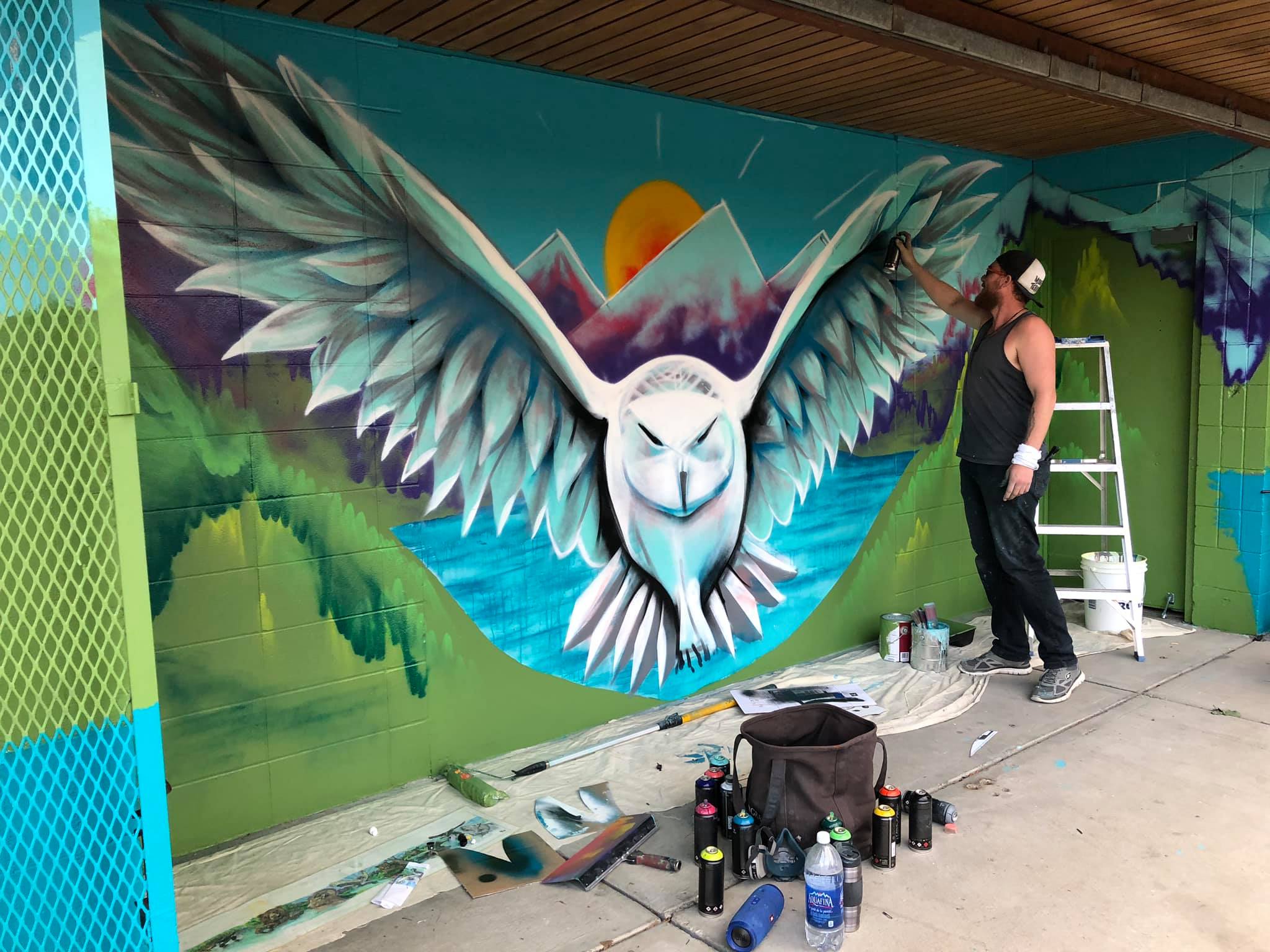

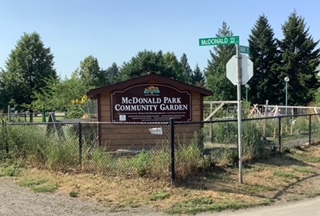
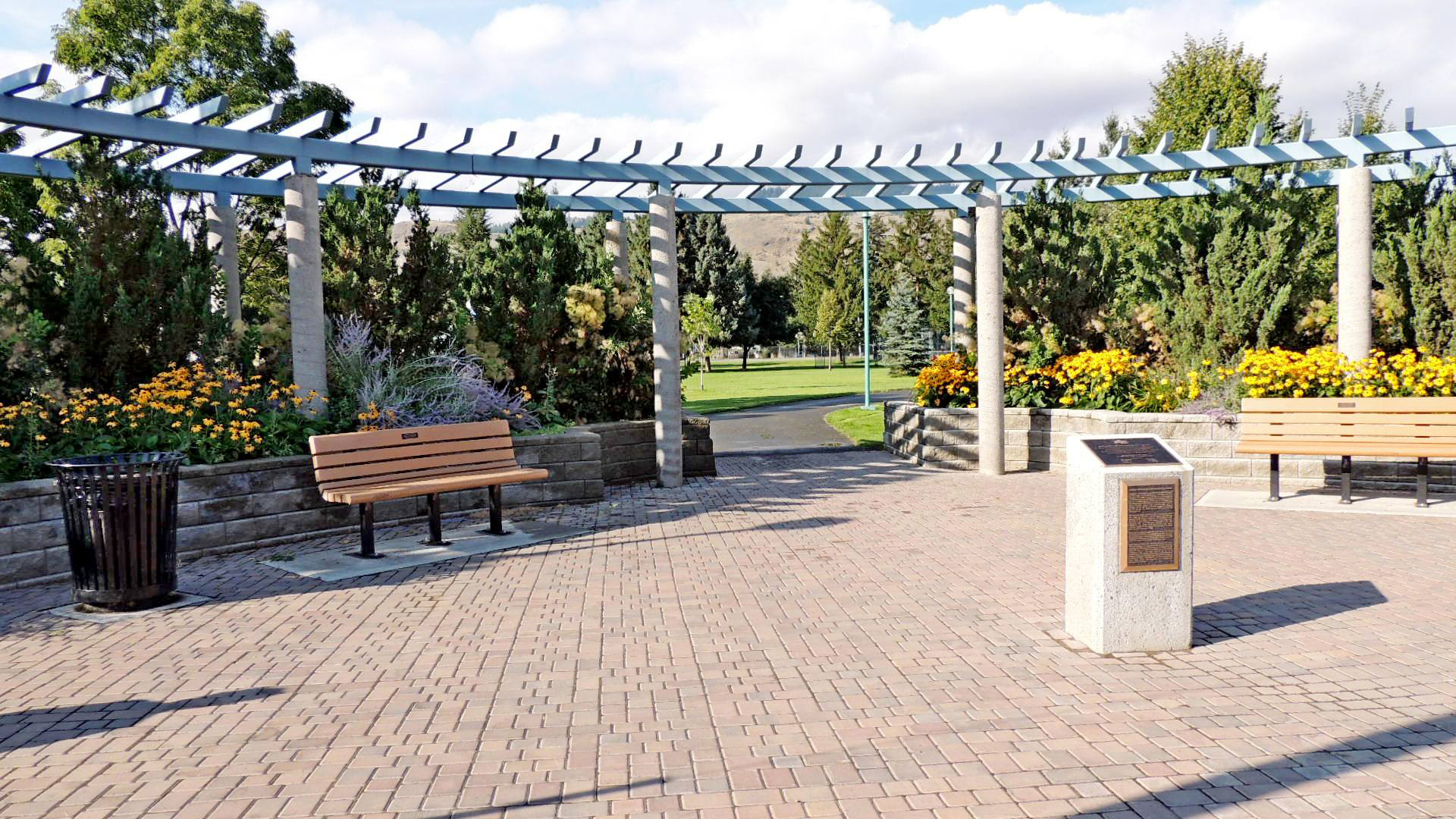
Events still occur on this land with an annual fairs, showcasing businesses, crafts, talent and multi-cultural foods and celebrations, songs and dance. Live music is performed on some summer evenings when the gazebo becomes a band shell.
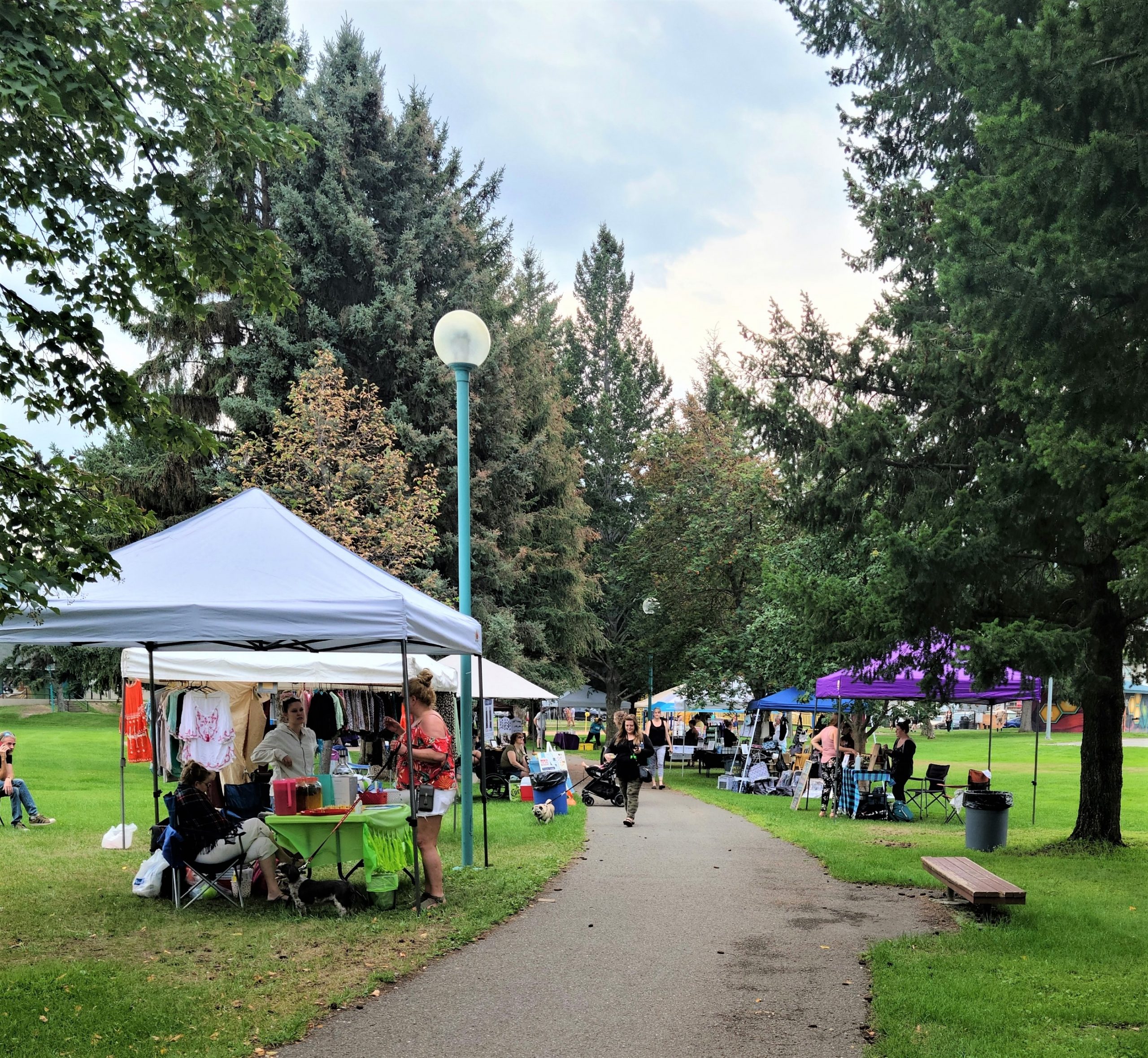
While enjoying the park, it is important to take a moment to envision this land as occupied by Indigenous Peoples living their lives, the various exhibitions and sports events that took place in a much larger park, and its historic place in aviation history.
Researched and written by Dr. M. Colleen Stainton with assistance of the Kamloops Museums and Archives and appreciation for editing by Barb Hicks.
Footnotes:
[1] The Kamloops Agricultural Association’s first fair occurred in 1892 and, until 1900, was held annually on Caledonian land on the south shore. The fair grew to include many interior communities and increasingly numerous and varied displays and contests creating the need for more space. (“Origins of the Kamloops Exhibition Association” in the Daily News, Kamloops, July 31, 1999).
[2] Daughter of Queen Victoria and wife of crowned Henry VII who became the mother of King George, V.
[3] For the full article describing the park development that year, see overlay by hovering cursor over the source
[4] For a very detailed and interesting description of this event over many years, see Norton Wayne, Kamloops History: Fictions Facts and Fragments, Plateau Press, Vancouver, B.C. 1948, p 33-50.
[5] See Heritage Plaque at 125 Victoria St.
[6] The annual event continued to grow and became a traditional, annual event enduring the war years of 1914-1918, increasing from the initial 30 children participating to more than 1000. Eventually it became too large an event for the firemen and it was taken over by a city committee and service clubs.
[7] No exhibition took place in 1912. Facilities developed in Riverside Park for the Agriculture Association’s annual exhibition from 1913 onwards, with fewer events due to reduced space in that location compared to Alexandra Park.
[8] https://www.kamloops.ca/sites/default/files/05-mcdonaldparkneighbourhoodplan_285818.pdf
[9] Mission: We are a non-profit society representing the McDonald Park Neighbourhood. Our Mission is to build community promoting and improving livability and quality of life in our neighbourhood


